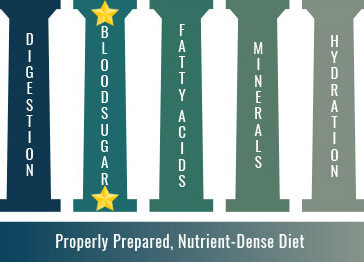The next step in our Foundations journey is Blood Sugar! Be sure to check out the first two: diet and digestion if you missed it!
On a very basic level blood sugar is the lens through which we view the world. The imbalance of our blood sugar can effect everything from energy, mood, hormone balance, brain health and even the integrity of every organ and blood vessel in the body. A diet high in sugar and refined carbohydrates can effect more than just our waistline and can cause a cascade of dysfunction throughout the entire body.
First, let’s talk about what the body uses for energy! The body takes in the macronutrients of carbohydrates, fat and protein and those are then generated into the form of energy that the body can used called adenosine triphosphate (ATP). This process happens within our cells. The mitochondria or the “powerhouse” of the cell controls the metabolic reactions to utilize certain nutrients from food that generate ATP. Carbohydrates are simple starches and sugars that are broken down into glucose which goes straight into the blood stream for either immediate fuel or storage. Fats are triglycerides or fatty acids that go into the lymph system, then the blood where they are used for cell building blocks, fuel or storage. Proteins are amino acids and polypeptides that enter into the blood and are then used for fuel or building blocks.
Glucose is the form of energy we are designed to run on. Every cell in your body and every living thing on earth, including bacteria, uses glucose for energy. Our body has an innate intelligence that is constantly monitoring the amount of glucose in our bloodstream to maintain balance. Too much or too little triggers the release of hormones to return the glucose levels to normal. Glycogen is the stored form of glucose and is stored first in the liver, then in the muscles, and is our glucose reserve for when we need it. So, after a carbohydrate heavy meal, any glucose not immediately used it converted to be stored as glycogen. When blood sugar levels are too low, the body converts glycogen back into glucose to raise the blood sugar. Ketones are another source of fuel for the body which are the byproduct of fats after the liver has broken them down. Ketones are water soluble fats that provide a source of energy for tissues including the muscles, brain and heart, they act as a stand in for glucose in the brain and they can replace a substantial amount of glucose required by the brain.
In other words, the body runs on BOTH fats and carbohydrates, and we were never really designed to run solely on carbohydrates. Why? Because if we are constantly eating carbohydrates our blood sugar continues to spike and then drop, requiring other mechanisms to step in and raise or lower it. We actually require a balance of unrefined carbohydrates, good fats and proteins as our fuel sources. If you picture a fire the carbohydrates are the kindling, the quick burning fuel, whereas the fats are the logs which burn and sustain energy longer.
There are three main organs that regulate blood sugar: liver, pancreas and the adrenal glands. The pancreas secretes insulin and glucagon straight into the bloodstream. Insulin is the key to stimulate uptake of glucose into cells, stimulates the liver to convert glucose to it’s stored form of glycogen and is the bodies only way to lower blood sugar levels. Glucagon helps maintain glucose levels in-between meals by increasing blood glucose, signals the liver to “make sugar” by breaking down glycogen into glucose or having the liver convert proteins to glucose. The liver is the main organ that responds to signals that indicate elevated or low blood sugar and a healthy liver is critical for blood sugar regulation. As stated above it is constantly converting glucose from it’s stored form back to it’s useable form depending on the needs of the body. The adrenals are tiny organs that sit on top of the kidneys and release hormones that play a large role in blood sugar regulation. The main hormone, cortisol is released when blood sugar is too low and also produces sex hormones. Most people don’t know that before puberty the adrenals produce hormones before the gonads and ovaries take over. When women go through menopause the body switches back from the ovaries to the adrenals producing the hormones. Cortisol is a very important hormone in blood sugar because it is needed when the liver cannot properly convert glycogen to glucose and mobilizes proteins from skeletal tissue for the liver to convert to glucose. It is needed to replenish glycogen storage, stimulates the breakdown of triglycerides and the release of fatty acids from fat tissue for fuel and has anti-inflammatory properties. Adrenaline, or epinephrine is another adrenal hormone that stimulates the conversion in the liver for immediate glucose need in fight or flight situations where the body needs a burst of energy really fast to respond to an emergency, basically a sugar dump into the bloodstream. When cortisol levels are consistently elevated in the body insulin receptors on cells don’t respond adequately to insulin and this strains the pancreas to secrete more insulin in order to get the glucose into the cells, causing insulin resistance.
One important factor to notice about blood sugar is that there are many ways for our body to raise blood sugar and there is only one way to lower it. The only thing that lowers blood sugar is insulin, because it causes the uptake of it into cells and out of the bloodstream. This is an imperative situation because as Americans we are drowning our bodies with sugar and refined carbohydrates, to the tune of over 140 pounds of sugar per person per year. Sugar is everywhere and food companies have become sneaky in their labeling of it, as well as the production of chemical sugars that are many times stronger than natural sugar. High fructose corn syrup is the number one source of calories in the American diet and is 20 times more damaging than glucose, causing premature aging and the interferes with key enzymes important for organ vitality, heart, testes, pancreas and liver. Sugar and these stronger sugar substances are also highly addictive, because they cause an adrenaline rush. Fructose is natural sugar found in vegetables and fruits that is naturally combined with fiber, vitamins, minerals, enzymes and beneficial phytonutrients that moderate the stress it causes to the metabolism. The standard American diet is full of just pure sugar, stripped down without all of the other beneficial parts that are usually found with it in nature.
As a result of this, we are experiencing more blood sugar dysfunction than ever. When it becomes chronic, the following conditions develop.
Hypoglycemia: Low blood sugar
- Common symptoms: craves sweets, irritable if meals are missed, dependent on coffee, light headed if meals are skipped, jittery or shaky, easily upset, nervous, memory issues, blurred vision, fatigue, insomnia, depression, infertility, slow metabolism and weight issues, hormonal issues
- Causes: chronic snacking, lots of high sugar snacks, use of caffeine or nicotine to suppress cravings, eating sweets instead of meals, lack of fat, protein and fiber in meals, easily irritable, highly fluctuating energy
Hyperglycemia: High blood sugar
- Common symptoms: fatigue after meals especially those high in carbohydrates, craves sweets, weight gain, difficulty losing weight, must have dessert after eating, fatigue, thyroid issues, depression, mood disorders, slow healing, premature aging, memory failure
- Causes: lack of exercise and movement, over eating, chronic snacking, eating sugar for pleasure, chronic prolonged stress, sugar burning metabolizer
Which can lead to…
Type 1 Diabetes:
- Body loses all structural ability to make insulin, caused by destruction of beta cells due to virus or auto antibody attack
- Typically occurs in adolescence
- Dependent on taking insulin in relation to carbohydrates in diet
Type 2 Diabetes:
- Loss of the beta cell function in the pancreas from prolonged demands of high insulin output
- Caused from high glycemic diet & stress
- Body can’t produce insulin because of over production
- Adult onset and a result of diet and lifestyle
- Can be a result of insulin resistance
Insulin Resistance:
- insulin receptor sites become unresponsive to the binding of insulin because of the constant presence of it from constant glucose presence
- Common symptoms: general fatigue, fatigue after meals especially high in carbs, can’t lose weight or weight gain, joint issues, depression, thyroid issues, fertility problems, hormonal imbalances, slow healing, premature aging, memory failure, craves sweets, must have dessert after eating
- Causes: lack of exercise/ movement, overeating, chronic snacking, eating sugar for pleasure, prolonged chronic stress, sugar burning metabolizer
How do you know if you are a sugar burner or a fat burner?
Sugar Burner:
- Can’t effectively access stored fat for energy
- Can’t access dietary fat for energy
- Depends on quick burning source of energy
- Burns through glycogen quickly during exercise
- Common symptoms: less able to be satiated, insistent hunger, increased carb cravings and intake, difficulty burning fat for weight loss, can’t go more than 2-3 hours between meals without getting crazy hungry
Fat Burner:
- Can burn stored fat for energy throughout the day, and can go 4-6 hours between meals
- Effectively oxidizes dietary fat for energy
- Plenty of energy on hand because they can access stored fat for energy also
- Rely on fat during exercise instead of glucose which means you can save it for when you really need it
- No change in energy after meals
- Sustained energy between meals
The first thing to address when there are blood sugar issues present is diet. Macronutrients need to be balanced at a starting ratio of 40% carbohydrates, 30% proteins and 30% fat. These will vary based on personal needs, training and overall activity levels, but is a good place to start. Limiting sugar in beverages and foods as much as possible is also important. Choosing better, more natural sources of sugar will provide the body with a balance of nutrients, vitamins and fiber, like in fruit, instead of just the sugar that’s found in most processed carbohydrates. Also limiting processed carbohydrates is essential to correct issues. Consuming carbs and fat together is also important because fat will slow the absorption of the sugar and create less of a spike in blood sugar. Incorporating regular movement into your lifestyle is also important, we live such a sedentary lifestyle and this contributes to blood sugar issues.
Next up we will be exploring the foundation of fat, which ties in with blood sugar since we want to focus on burning and running off of fat instead of sugar!

